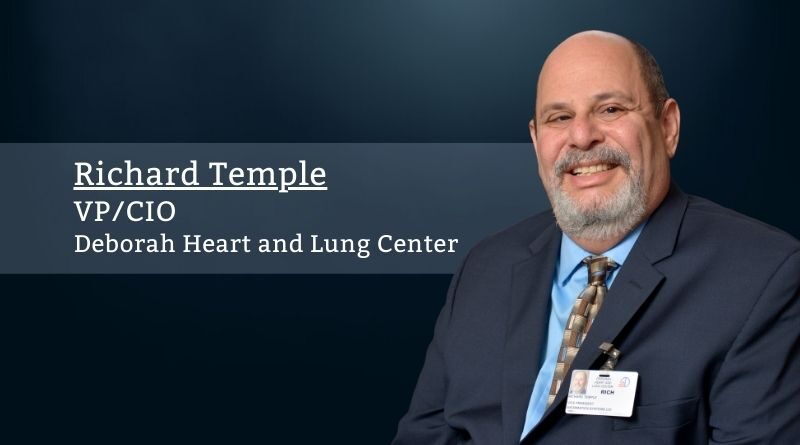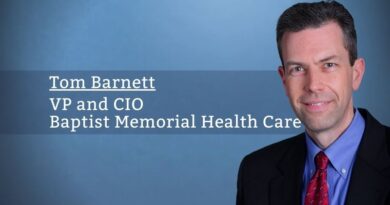Realizing the Potential of Artificial Intelligence at a Small Specialized Cardiovascular Hospital
By Richard S. Temple, VP/CIO, Deborah Heart and Lung Center
I come to you today as the Vice President and Chief Information Officer for Deborah Heart and Lung Center, an 89-bed cardiovascular specialty hospital in the Pine Barrens of southern New Jersey. Our commitment to patient care excellence has enabled us to be a proud Alliance Partner of the Cleveland Clinic Heart, Vascular and Thoracic Institute. We also have one other thing that is incredibly unique about us: we are one of three hospital systems in the United States that has Congressional dispensation to not balance-bill a patient for services received at our hospital. That is part of our founding mission. That, combined with a deep caring and kindness, is baked into the DNA of everyone who works at Deborah.
Our ongoing commitment to providing the best cardiovascular care, coupled with our motto that “there is no price on life,” makes Deborah an incredible place to work, but also brings unique challenges. Not having self-pay reimbursement means we forego a significant source of revenue and always means that we have to be very resourceful about finding ways to “do more with less.” We have embraced Artificial Intelligence (AI) and, in particular, Robotic Process Automation (RPA) as a vehicle for allowing us to automate critical work processes that are human resource-intensive and subject to errors or omissions due to people being away from work.RPA is, in essence, software that mimics what a human being would do to perform certain key processes such as logging into a computer system, entering data from a spreadsheet or worklist into that system, following the screen paths that the system generates, and ultimately, consuming the information back into our core electronic health record (EHR) system. An RPA system has intrinsic benefits such as running 24×7, never taking a lunch break, and never getting distracted from its duties by external stimuli or other priorities that may arise. In an ideal world, “set it and forget it” and let the RPA system do what the hospital used to have multiple employees do in the past.
Our ongoing commitment to providing the best cardiovascular care, coupled with our motto that “there is no price on life,” makes Deborah an incredible place to work, but also brings unique challenges.
However, like many new technologies, it is easier said than done actually to bring RPA to fruition. The first basic challenge is to reassure employees that their job isn’t being “replaced by a computer.” For us, as leaders at the hospital, we know instinctively that we are not looking to use RPA as a vehicle for reducing headcount; rather, we want to seize the opportunity to leverage existing staff to perform tasks that we otherwise would have to hire new people for, or to do work that is uniquely ‘human-centric;” for example, assisting patients in ways that positively impact their “patient experience” during their time at the hospital, as well as before and after the time they actually visit our hospital. We have seen this conundrum with other technologies we have deployed — even with the implementation of our EHR — and have, I believe, demonstrated that we walk the walk as well as talk the talk as it relates to our commitment not to use technology as an agent to facilitate downsizing.
With that mindfulness, we embarked on our initial foray into RPA: automating the process of checking insurance eligibility for all our patients. In the past, that had been a significant manual undertaking: capturing the key demographic information for the patient, entering it into one of several web portals, retrieving the information (in multiple layouts, based on different payors), and entering that insurance information into the EMR. We worked with our partner (Olive) to map out in excruciating detail, who does what and when, what websites they have to visit, what different paths they may have to go down to extract data based on the user’s response to different queries, and ultimately, how they extract the data they need and put it into our Meditech EHR system. Our partner then built software that mimicked what the user did, but, as you can imagine, there were, and continue to be, more considerations. The software has to find the list of patients for whom insurance queries need to be performed, process the list line-by-line, update the EHR with what it finds. Finally, there needs to be a process through which error situations can be logged to an audit report, so an individual can work the “exceptions.”
The testing and validation of RPA-related processes are much more complex than anyone could imagine. Once everything has been signed off on and the RPA process moved live, the benefits are truly phenomenal and consistent with what we hoped they would be.
Based on the success of our insurance eligibility RPA project, we are in the midst of a much more complex project which will have an even greater benefit to our hospital: automating the Prior Authorization process for certain types of services that insurance payors typically require and approve before they will pay them. This use case is even more complicated because there are so many more paths that need to be followed, based on the individual payor, the type of service, and the user’s responses to initial queries dictating follow-up questions that the payor will electronically ask. Mapping these responses and as many different scenarios as possible is a herculean undertaking and we are in the midst of doing this. However, the project is moving forward in a very promising manner. When done, it will really represent a “holy grail” of sorts where AI and RPA can transform a vital and convoluted part of a hospital’s revenue cycle, maximizing potential reimbursement and creating great operational efficiencies.
AI may be challenging and may require a significant investment of blood, sweat, and tears (and dollars!) to build, but the benefits truly are boundless!



